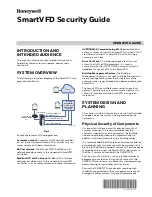
D14869.11
Codec C20 API Reference Guide TC7.0, JANUARY 2014.
Copyright © 2010–2014 Cisco Systems, Inc. All rights reserved.
52
Cisco TelePresence System Codec C20
API Reference Guide
Security configuration
xConfiguration Security Audit Logging Mode
Determine where to record or transmit the audit logs. The audit logs are sent to a syslog server.
When using the External/ExternalSecure modes and setting the port assignment to manual in the
Security Audit Server PortAssignment setting, you must also enter the address and port number for
the audit server in the Security Audit Server Address and Security Audit Server Port settings.
Requires user role:
AUDIT
Value space:
<Off/Internal/External/ExternalSecure>
Off:
No audit logging is performed.
Internal:
The system records the audit logs to internal logs, and rotates logs when they are full.
External:
The system sends the audit logs to an external syslog server. The syslog server must
support UDP.
ExternalSecure:
The system sends encrypted audit logs to an external syslog server that is verified
by a certificate in the Audit CA list. The Audit CA list file must be uploaded to the codec using
the web interface. The common_name parameter of a certificate in the CA list must match the IP
address of the syslog server, and the secure TCP server must be set up to listen for secure (TLS)
TCP Syslog messages.
Example:
xConfiguration Security Audit Logging Mode: Off
xConfiguration Security Audit OnError Action
Determine what happens when the connection to the syslog server is lost. This setting is only
relevant when Security Audit Logging Mode is set to ExternalSecure.
Requires user role:
AUDIT
Value space:
<Halt/Ignore>
Halt:
If a halt condition is detected the system codec is rebooted and only the auditor is allowed to
operate the unit until the halt condition has passed. When the halt condition has passed the audit
logs are re-spooled to the syslog server. Halt conditions are: A network breach (no physical link),
no syslog server running (or incorrect address or port to the syslog server), TLS authentication
failed (if in use), local backup (re-spooling) log full.
Ignore:
The system will continue its normal operation, and rotate internal logs when full. When the
connection is restored it will again send its audit logs to the syslog server.
Example:
xConfiguration Security Audit OnError Action: Ignore
xConfiguration Security Audit Server Address
The audit logs are sent to a syslog server. Enter the IP address of the syslog server. Only valid IPv4
or IPv6 address formats are accepted. Host names are not supported. This setting is only relevant
when Security Audit Logging Mode is set to External or ExternalSecure.
Requires user role:
AUDIT
Value space:
<S: 0, 64>
Format:
A valid IPv4 address or IPv6 address
Example:
xConfiguration Security Audit Server Address: ""
xConfiguration Security Audit Server Port
The audit logs are sent to a syslog server. Enter the port of the syslog server that the system shall
send its audit logs to. This setting is only relevant when Security Audit PortAssignment is set to
Manual.
Requires user role:
AUDIT
Value space:
<0..65535>
Range:
Select a value from 0 to 65535.
Example:
xConfiguration Security Audit Server Port: 514
xConfiguration Security Audit Server PortAssignment
The audit logs are sent to a syslog server. You can define how the port number of the external
syslog server will be assigned. This setting is only relevant when Security Audit Logging Mode is
set to External or ExternalSecure. To see which port number is used you can check the Security
Audit Server Port status. Navigate to Configuration > System status on the web interface or; if on a
command line interface, run the command xStatus Security Audit Server Port.
Requires user role:
AUDIT
Value space:
<Auto/Manual>
Auto:
Will use UDP port number 514 when the Security Audit Logging Mode is set to External. Will
use TCP port number 6514 when the Security Audit Logging Mode is set to ExternalSecure.
Manual:
Will use the port value defined in the Security Audit Server Port setting.
Example:
xConfiguration Security Audit Server PortAssignment: Auto
Contents
Introduction
About the API
xConfiguration
Appendices
xCommand
xStatus
xConfiguration
















































